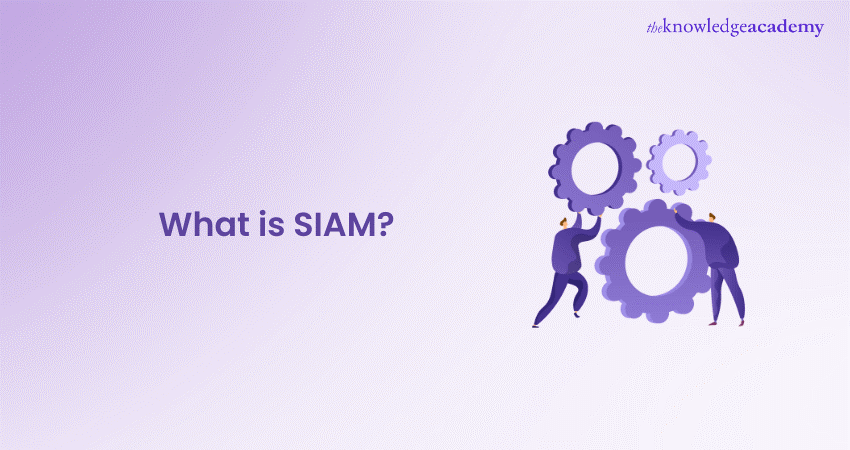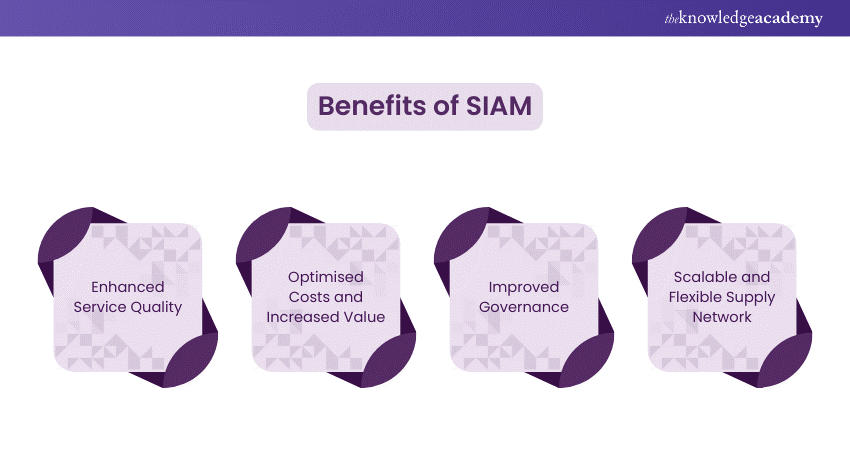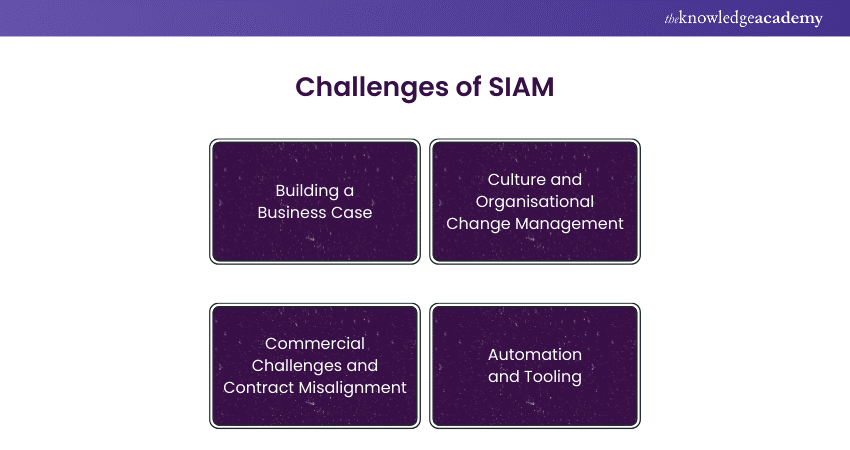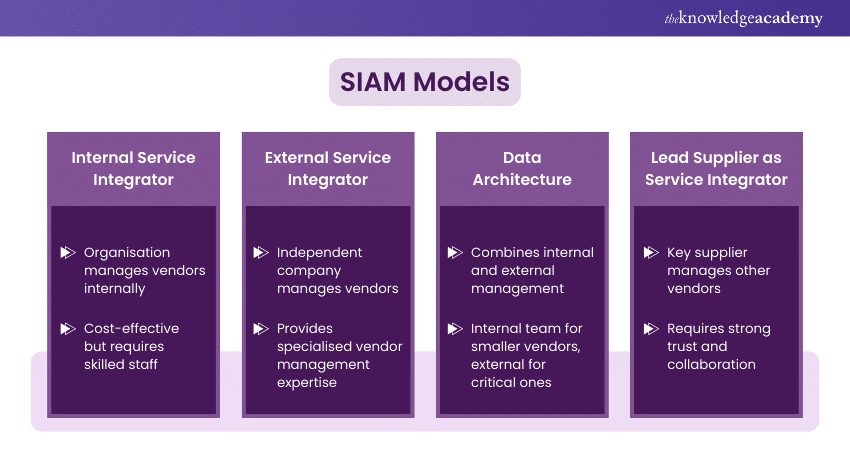We may not have the course you’re looking for. If you enquire or give us a call on 01344203999 and speak to our training experts, we may still be able to help with your training requirements.
Training Outcomes Within Your Budget!
We ensure quality, budget-alignment, and timely delivery by our expert instructors.

Ever struggled to align multiple IT Service Providers? Managing a complex IT ecosystem can be overwhelming. This is where SIAM comes to the rescue. What is SIAM? It’s a strategic approach to managing multiple IT Service Providers, ensuring they work cohesively towards common goals.
This blog will delve into What is SIAM, exploring its benefits such as cost reduction, improved service quality, and enhanced Risk Management. We'll also discuss the challenges organisations face when implementing SIAM and provide practical tips for overcoming them. Join us as we unravel the complexities of managing multiple IT Service Providers and discover how SIAM can transform your IT landscape.
Table of Contents
1) What is Service Integration?
2) Key Elements of Service Integration
3) What are the Benefits of SIAM?
4) What are the Challenges of SIAM?
5) How do SIAM and IT Service Management/ITIL fit Together?
6) Selecting the Right SIAM Model
7) Conclusion
What is Service Integration?
In this section, we will explore What is SIAM. Service Integration and Management (SIAM) also known as Service Management, is a strategic approach used to manage multiple Service Providers effectively and efficiently within an organisation. In today's business environment, companies often depend on a variety of external providers, such as IT outsourcing firms, cloud services, human resources agencies, and other specialised vendors.
The challenge is ensuring these diverse providers work together cohesively to achieve the organisation's overarching goals. Service Integration addresses this issue by creating a framework that fosters collaboration, coordination, and governance among the various Service Providers, ensuring seamless and unified service delivery.
Key Elements of Service Integration
Let us now explore the foundational aspects that ensure seamless coordination and efficiency in managing multiple Service Providers.
End-to-End Service Management
End-to-End Service Management involves overseeing the entire lifecycle of services provided by multiple vendors, from planning and design to delivery and support. It ensures that all services work seamlessly together, meeting the organisation's needs and providing a consistent user experience.
Service Agreements and SLAs
Service Agreements and Service Level Agreements (SLAs) are formal contracts that define the expectations, responsibilities, and standards for service delivery between an organisation and its Service Providers. These agreements specify key performance metrics, response times, and quality standards to ensure that all parties have a clear understanding of the required service levels.
Service Integration Role
The Service Integration Role is a designated function within an organisation responsible for coordinating and managing multiple Service Providers. This role involves overseeing the integration and alignment of various services, ensuring they collectively contribute to the organisation's objectives. The Service Integration Manager serves as the primary liaison, ensuring effective communication and collaboration between providers.
Governance and Performance Management
Governance and Performance Management involve establishing policies, procedures, and frameworks to oversee the activities of Service Providers. This includes monitoring performance against SLAs, ensuring compliance with organisational standards, and managing risks.
Effective governance helps maintain accountability and ensures that services are delivered efficiently and effectively.
Service Reporting and Communication
Service Reporting and Communication involve regularly providing stakeholders with updates on service performance, issues, and improvements. This includes generating reports that detail key metrics, trends, and insights, as well as communicating any changes or updates to services. Clear and consistent communication helps maintain transparency and keeps all stakeholders informed.
Service Continual Improvement
Service Continual Improvement focuses on continuously enhancing the quality and efficiency of services through regular assessment and feedback. This process entails pinpointing areas for improvement, implementing necessary changes, and tracking their impact. The aim is to cultivate a culture of continuous enhancement, ensuring that services adapt to meet evolving organisational needs and expectations.
Become a Service Integrator professional with our SIAM™ Professional Training- Sign up now!
What are the Benefits of SIAM?
Adopting SIAM offers several key benefits, including:

1) Enhanced Service Quality: Ensures consistent and high-quality service delivery across multiple providers.
2) Optimised Costs and Increased Value: Reduces operational costs and maximises value by streamlining processes and eliminating redundancies.
3) Improved Governance: Centralised oversight enhances accountability, compliance, and risk management.
4) Scalable and Flexible Supply Network: Allows for easy adaptation to changes in the business environment and integration of new Service Providers.
Early adopters of SIAM transitioned from single, monolithic outsourced contracts to a diverse range of specialised Service Providers. They recognised that their existing contracts offered poor value for money and sought to ensure better value in the new, multi-provider environment.
What are the Challenges of SIAM?
Adopting SIAM involves a substantial organisational transformation, presenting several challenges, including:

a) Building a Business Case: Justifying the investment and demonstrating the potential benefits of SIAM to stakeholders can be challenging.
b) Culture and Organisational Change Management: Fostering a culture of collaboration and managing the shift in organisational dynamics can be difficult.
c) Commercial Challenges and Contract Misalignment: Existing contracts may not align with the new SIAM framework, requiring renegotiation or modification.
d) Automation and Tooling: Implementing the right tools and automation processes to support SIAM can be complex and resource intensive.
Master Service Integration with SIAM™ Certification! Enroll now to lead multi-vendor IT environments effectively.
How do SIAM and IT Service Management/ITIL fit Together?
There is often confusion about the relationship between SIAM and IT Service Management frameworks like ITIL. It's important to clarify that SIAM does not replace ITIL processes and procedures. Instead, SIAM builds on and extends these established processes, adapting them to a multi-supplier environment.
For instance, while we may be familiar with incident management, SIAM addresses the complexities that arise when an incident involves multiple Service Providers, potentially up to fifteen or more. SIAM provides the structure and coordination needed to manage such scenarios effectively.
Moreover, SIAM's application isn't limited to IT alone. It can be extended across the entire enterprise, encompassing areas such as HR, logistics, and facilities management. This broader scope allows organisations to integrate and manage a wide range of services from different suppliers under a unified framework.
Kickstart your IT Management journey with our VeriSM™ Foundation Training -Register now!
Selecting the Right SIAM Model
Selecting the right SIAM Model is crucial for successful implementation. It ensures alignment with business objectives, effective Service Integration, and optimised resource utilisation. The wrong model can lead to inefficiencies, conflicts, and missed opportunities. Here are the 4 prominent SIAM Models explained

Internal Service Integrator
The internal service integrator model involves the organisation itself managing and coordinating multiple service vendors. In this approach, the company retains control over all vendor relationships and integrates the services internally. This can be a cost-effective strategy as it avoids the additional expenses associated with hiring an external service integrator.
However, the success of this model heavily depends on the skills and authority of the person or team responsible for Service Integration. They must possess a deep understanding of Service Integration processes and have the authority to enforce policies and standards across all vendors. Without these capabilities, the organisation may struggle to achieve the desired efficiencies and quality improvements.
External Service Integrator
In the external service integrator model, an independent, specialist company is hired to manage all vendor relationships on behalf of the organisation. This external integrator brings a wealth of experience in vendor management, offering expert oversight and coordination of services. The key advantage of this model is the professional expertise and impartiality the external integrator provides, ensuring that all vendors meet the required standards and perform effectively.
However, the cost of employing an external service integrator can be significant. Despite the expense, many organisations find the investment worthwhile due to the potential for improved service quality, streamlined operations, and the external integrator's ability to manage complex vendor ecosystems.
Hybrid Service Integrator
The hybrid service integrator model combines elements of both internal and external integration. In this setup, an internal team may manage less critical or smaller vendors, while an external service integrator oversees more critical or complex vendor relationships. This approach allows the organisation to benefit from the expertise of an external specialist while also building internal capabilities.
The hybrid model is often used as a transitional strategy, enabling the internal team to gain experience and develop skills in Service Integration. Over time, the organisation may shift towards a fully internal service integrator model, as the internal team becomes more adept at managing all vendor relationships independently. This approach offers flexibility and scalability, allowing the organisation to adapt to changing needs and complexities in its vendor landscape.
Lead Supplier as Service Integrator
In this model, a key supplier is appointed to manage other vendors. This arrangement requires a high level of trust between the organisation and the lead supplier. When trust is established, this model can be highly effective.
It's also advantageous to consolidate services under fewer vendors where possible. For example, instead of hiring nine vendors for different IT infrastructure needs, an organisation might work with three vendors, each covering multiple requirements. Even if these vendors subcontract, a single agreement with each ensures consistent quality standards.
Enhance your skills to lead seamless Service Integration with our SIAM™ Foundation Training- Join now!
Conclusion
We hope this blog helped you understand What is SIAM and the importance of Service Integration and Management. SIAM is a strategic approach to managing and integrating multiple IT service providers. By establishing a unified service management framework, SIAM delivers a cohesive IT service experience, driving efficiency, cost savings, and risk mitigation.
Frequently Asked Questions

SIAM can be implemented in organisations of all sizes. While it is often associated with larger enterprises, smaller organisations can also benefit from SIAM's structured approach to managing multiple Service Providers and improving service delivery.

Key best practices include securing executive sponsorship, clearly defining roles and responsibilities, ensuring strong communication channels, involving all stakeholders, and providing adequate training. A phased implementation approach can help manage change effectively and mitigate risks.

Common pitfalls include inadequate stakeholder engagement, lack of clear governance structures, insufficient training, and underestimating the cultural shift required. Avoiding these pitfalls requires thorough planning, strong leadership, and ongoing communication throughout the transition.

The Knowledge Academy takes global learning to new heights, offering over 30,000 online courses across 490+ locations in 220 countries. This expansive reach ensures accessibility and convenience for learners worldwide.
Alongside our diverse Online Course Catalogue, encompassing 17 major categories, we go the extra mile by providing a plethora of free educational Online Resources like News updates, Blogs, videos, webinars, and interview questions. Tailoring learning experiences further, professionals can maximise value with customisable Course Bundles of TKA.

The Knowledge Academy’s Knowledge Pass, a prepaid voucher, adds another layer of flexibility, allowing course bookings over a 12-month period. Join us on a journey where education knows no bounds.

The Knowledge Academy offers various SIAM™ Training, including the SIAM™ Professional Training, and SIAM™ Foundation Training. These courses cater to different skill levels and provide comprehensive insights into VeriSM.
Our IT Service Management Blogs cover a range of topics related to IT Service Management, offering valuable resources, best practices, and industry insights. Whether you are a beginner or looking to advance your Service Integration Skills, The Knowledge Academy's diverse courses and informative blogs have got you covered.
Upcoming IT Service Management Resources Batches & Dates
Date
 SIAM™ Professional Training
SIAM™ Professional Training
Thu 2nd Jan 2025
Thu 27th Mar 2025
Thu 26th Jun 2025
Thu 30th Oct 2025







 Top Rated Course
Top Rated Course



 If you wish to make any changes to your course, please
If you wish to make any changes to your course, please


